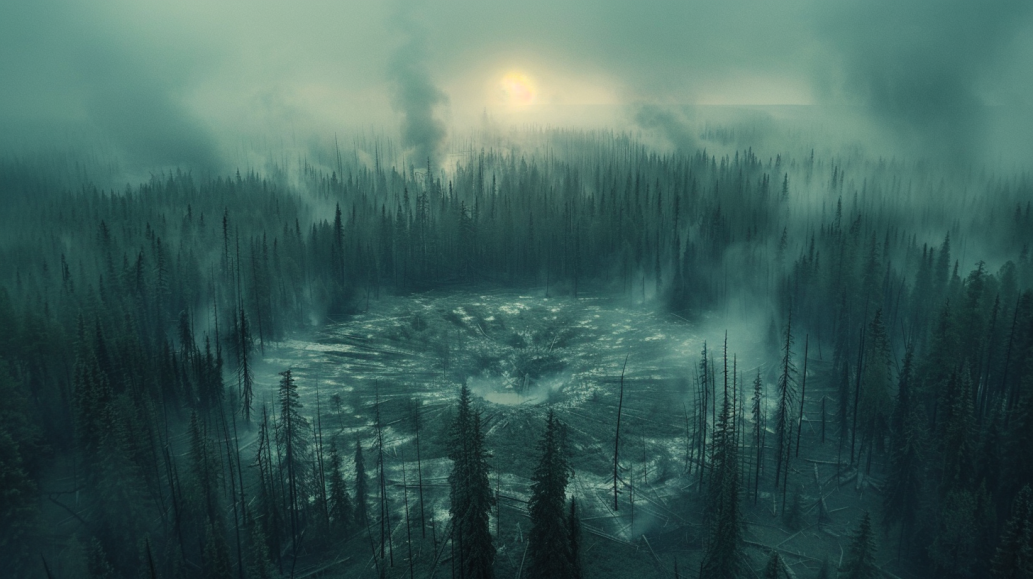Introduction
On June 30, 1908, a massive explosion rocked the remote Tunguska region of Siberia, flattening 800 square miles of forest. The force of the blast was estimated to be 1,000 times more powerful than the atomic bomb dropped on Hiroshima. Despite extensive research, the cause of the Tunguska event remains a mystery. The leading theory is a meteoroid or comet airburst, but no impact crater has ever been found.
The Event Unfolds
The Explosion
Early in the morning of June 30, 1908, a bright flash of light streaked across the sky, followed by a series of powerful explosions. Witnesses described seeing a fireball moving through the atmosphere and feeling a shockwave that knocked people off their feet and shattered windows hundreds of miles away. The explosion was so intense that it flattened an estimated 80 million trees over an area of 2,150 square kilometers (830 square miles) in the Tunguska region.
Immediate Aftermath
The immediate aftermath of the explosion was chaos. Local inhabitants, including the Evenki people, were thrown to the ground by the force of the blast. The shockwave caused fires that burned for days, and a black, ash-laden rain fell over the area. Despite the devastation, no human fatalities were reported, likely due to the remote and sparsely populated nature of the region.
Early Investigations
Leonid Kulik’s Expedition
In 1927, nearly two decades after the explosion, Russian mineralogist Leonid Kulik led the first scientific expedition to the Tunguska region. Kulik’s team expected to find an impact crater and remnants of a meteorite. Instead, they found a vast area of scorched and flattened trees but no significant fragments of extraterrestrial material.
Lack of an Impact Crater
The absence of an impact crater puzzled scientists. The devastation suggested a powerful explosion, but without a crater, the cause remained elusive. This led to the theory that the object responsible for the Tunguska event had disintegrated or exploded in the atmosphere before reaching the ground.
Theories and Explanations
Meteoroid or Comet Airburst
The most widely accepted theory is that the Tunguska event was caused by the airburst of a meteoroid or comet. As the object entered the Earth’s atmosphere at high speed, the pressure and heat caused it to explode mid-air. This would explain the lack of an impact crater and the widespread damage.
Alternative Theories
Natural Gas Explosion
One alternative theory suggests that a natural gas explosion could have caused the Tunguska event. According to this hypothesis, a large release of methane from the Earth’s crust could have ignited and caused the explosion. However, this theory lacks substantial evidence.
Black Hole or Antimatter
More speculative theories propose that the Tunguska event was caused by a small black hole passing through the Earth or the annihilation of a chunk of antimatter. These ideas are fascinating but are not supported by the available scientific data.
Modern Investigations
Advances in Technology
Modern technology has allowed scientists to study the Tunguska event in greater detail. Satellite imagery, aerial surveys, and ground-penetrating radar have provided new insights into the event’s impact on the landscape.
Recent Expeditions
Recent expeditions to the Tunguska region have continued to search for evidence to support the meteoroid or comet airburst theory. Researchers have found microscopic fragments that may be of extraterrestrial origin, but conclusive proof remains elusive.
Cultural Impact
Influence on Popular Culture
The Tunguska event has captured the imagination of writers, filmmakers, and conspiracy theorists. It has been featured in numerous books, movies, and TV shows, often portrayed as a mysterious or supernatural occurrence.
Scientific Significance
The Tunguska event has significant scientific implications. It has led to increased awareness of the potential dangers posed by near-Earth objects and has influenced the development of planetary defense strategies.
Conclusion
The Tunguska event remains one of the greatest unsolved mysteries in modern history. Despite extensive research and numerous theories, the exact cause of the explosion is still unknown. Whether it was a meteoroid, comet, or something more exotic, the Tunguska event continues to intrigue scientists and the public alike.
FAQs
1. What was the Tunguska event?
The Tunguska event was a massive explosion that occurred on June 30, 1908, in the Tunguska region of Siberia, flattening 800 square miles of forest.
2. What caused the Tunguska event?
The leading theory is that the Tunguska event was caused by the airburst of a meteoroid or comet, but no impact crater has ever been found.
3. Were there any human casualties in the Tunguska event?
No human fatalities were reported, likely due to the remote and sparsely populated nature of the region.
4. Has the Tunguska event been explained conclusively?
Despite extensive research, the exact cause of the Tunguska event remains a mystery, with several competing theories.
5. How has the Tunguska event influenced popular culture?
The Tunguska event has been featured in numerous books, movies, and TV shows, often portrayed as a mysterious or supernatural occurrence.

